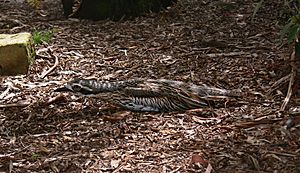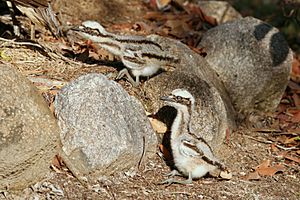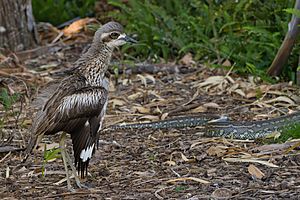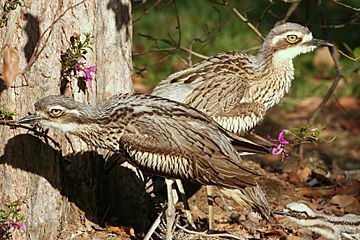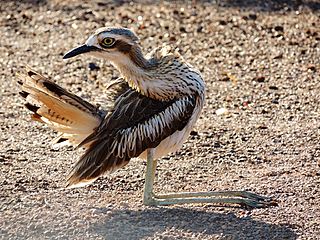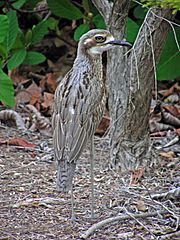Bush stone-curlew facts for kids
Quick facts for kids Bush stone-curlew |
|
|---|---|
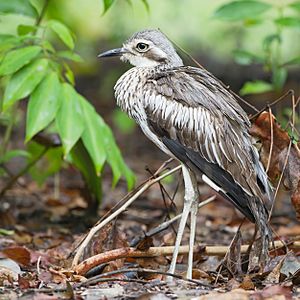 |
|
| An adult bush stone-curlew in northern Queensland | |
| Conservation status | |
| Scientific classification | |
| Genus: |
Burhinus
|
| Species: |
grallarius
|
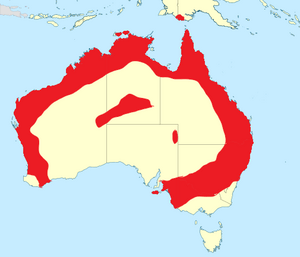 |
|
| range | |
| Synonyms | |
|
Charadius grallarius Latham, 1801 Burhinus magnirostris (Latham, 1801) |
|
The bush stone-curlew (Burhinus grallarius), also known as the bush thick-knee, is a large bird that lives on the ground. It is found only in Australia. These birds prefer open plains and woodlands. They slowly hunt at night for small creatures like insects.
Bush stone-curlews are grey-brown with dark streaks. They have big eyes and long legs. Even though they can fly, they usually hide during the day. Their feathers help them blend in with their surroundings. When they see someone, they stand very still to avoid being noticed. Both male and female birds take care of their two eggs. They lay their eggs right on the bare ground, often near bushes or fallen branches for shade.
Contents
About the Bush Stone-Curlew
The bush stone-curlew belongs to a family of birds called Burhinidae, which are known as thick-knees. These birds have large eyes and long legs. They are slender and have grey and brown feathers with special markings.
What does it look like?
The bush stone-curlew has dark streaks on its buff and greyish-white feathers on its back. Its wings have spotted patterns. The feathers on its belly are also strongly streaked with dark brown over white and buff colors.
This bird is about 55 centimeters (22 inches) long. Its bill is about 4.5 centimeters (1.8 inches) long, and its tail is about 18 centimeters (7 inches) long. When its wings are spread, they can reach almost 1 meter (3.3 feet) across.
When the bird flies, its black flight feathers show a light buff patch. It also has a light area on its shoulder. Its head has a dark band of feathers over the eye and down the neck. The forehead and area above the eye are buff colored. The bird's eyes are bright yellow, and the skin around them is black. Its long legs are olive-green, and its bill is dark.
Male and female bush stone-curlews look very similar. Young birds have lighter feathers but otherwise look like the adults.
What does it sound like?
The bush stone-curlew has a very loud voice that can be heard from far away. Its call sounds like "weeloo" and is often described as eerie and sad. It's a common sound at night in the Australian bush.
These birds call more often when the weather is changing, especially when rain is coming. Sometimes, several birds will call together, making their night sounds even more amazing.
What about their eggs?
The eggs are usually stone grey with brownish spots. This helps them blend in with the ground. The size of the eggs can vary, but they are usually about 53 by 39 millimeters (2.1 by 1.5 inches). Even eggs in the same nest can be slightly different sizes.
No other bird in Australia looks quite like the bush stone-curlew. The beach stone-curlew, another bird in the same family, lives only on the coast and has different feathers and a bigger bill.
How do they behave?
Like most stone-curlews, the bush stone-curlew is mostly active at night. It hunts small animals that live in grasslands. These include frogs, spiders, insects, snails, crabs, snakes, lizards, and small mammals. They usually find their food by picking it up or probing in soft soil or rotting wood. Sometimes, they also eat seeds or plant roots, especially when food is scarce. Birds usually hunt alone or in pairs over a large area, especially on nights when the moon is bright.
Hiding during the day
During the day, bush stone-curlews usually stay still. They hide among tall grass or in the shade of bushes and trees. They rely on their camouflaged feathers to protect them from predators. If they are disturbed, they freeze and stay motionless. This works well against predators that hunt by sight, like birds of prey and humans. However, it doesn't help much against animals that hunt by smell, like foxes or dingoes.
Even if you get close to a hidden bird, it will often stay frozen. If it needs to move away from danger, it will crouch down and walk quietly into plants. It will only fly if it is chased very hard.
Even though they look a bit clumsy and often freeze, these birds are very good at moving on the ground. They are fast and agile. While they don't often fly during the day, they are not clumsy in the air. Their flight is fast and direct on their long, wide wings.
Threat displays
The bush stone-curlew is probably heard more often than it is seen. Its call sounds like a wail or a scream at night. When it is scared, it makes a screeching sound, similar to a possum. If they feel threatened, especially near their nest, they might raise their wings wide and high. This looks very impressive and is a warning. They also make a loud, rough hissing noise.
Bush stone-curlews are sometimes seen in groups. But during the breeding season, you usually only find a mating pair in one area. Like other birds that nest on the ground, the female just chooses a spot to lay her eggs. She doesn't build a fancy nest. Both parents take care of the eggs. If disturbed early in the incubation, the parent might quietly move away from the nest. But later, they will stay to protect the eggs. The parent will adopt its frozen posture and lie over the eggs to try and hide them. If an egg is found by an intruder, the parent might move it a short distance away.
Where do they live?
The bush stone-curlew can live in many different places. However, you rarely see them in rainforests, very dry deserts, or busy cities and farms. They live in open forests, eucalyptus woodlands, the edges of rainforests, grassy plains, dry scrubland, and along rivers inland. They don't migrate (move long distances seasonally), but they might move to a different spot in their local area if the weather changes.
These birds are common near the cities of Brisbane, Cairns, and Townsville in northeast Australia. But they are not found around cities in the south of Australia. You can find them across most of Australia, except for the west coast and Tasmania. They are still common in the tropical and subtropical north. However, they have become very rare in the less fertile south, where they used to be common.
In the past, bush stone-curlews were common in Southwest Australia. But their numbers dropped a lot during the 1900s. This decline is mostly blamed on the introduction of the red fox to Australia. Cats are also a threat to them. Sometimes, efforts to control other pests, like rabbits, also harmed these birds. They could get caught in rabbit traps or be affected by poisoned water meant for rabbits.
The bush stone-curlew used to live across most of mainland Australia. Now, their range has shrunk by about 90%. They can also be found on some islands near Australia. A very small group of them also breeds in southern New Guinea.
Sometimes, these curlews found safety near farms. Farmers would look out for them, and their dogs would protect them from foxes. Young birds have even been known to become partly tame on rural properties.
Are they in danger?
Bush stone-curlews are still quite common in northern Australia. But they have become rare in the south. Many experts think that foxes eating them is a main reason for their decline. However, there are places where foxes are common, but the curlew population is still healthy. So, the exact reasons are not fully known.
Losing their natural homes and breaking up their habitats has definitely been a big problem. This might be the main reason for their decline. But some evidence suggests that these birds actually like farmland that still has patches of native plants more than completely untouched areas.
Since 2014, bush stone-curlews have been brought back to a protected area in Mulligans Flat Woodland Sanctuary in Canberra. This is being done using special methods to help them settle in.
The IUCN Red List says that the bush stone-curlew is not currently threatened. This is a change from an earlier listing where it was considered "near threatened" with extinction. However, their population is still decreasing. In 2016, it was estimated that there were between 10,000 and 15,000 individual birds. The big drops in numbers that happened when Australia was first settled are thought to have slowed down in the 32 years before the 2016 assessment.
In Australia, the bush stone-curlew is not listed as threatened under a main national law called the Environment Protection and Biodiversity Conservation Act 1999. It is common in Queensland and not considered threatened there. However, in New South Wales, it is considered endangered. In South Australia, it is listed as "vulnerable." In Victoria, it is listed as "threatened" and also as "endangered" on a special advisory list. Plans are being made to help this species recover and manage its future in Victoria.
Images for kids
-
A bush stone-curlew blending into its environment
See also
 In Spanish: Alcaraván colilargo para niños
In Spanish: Alcaraván colilargo para niños



